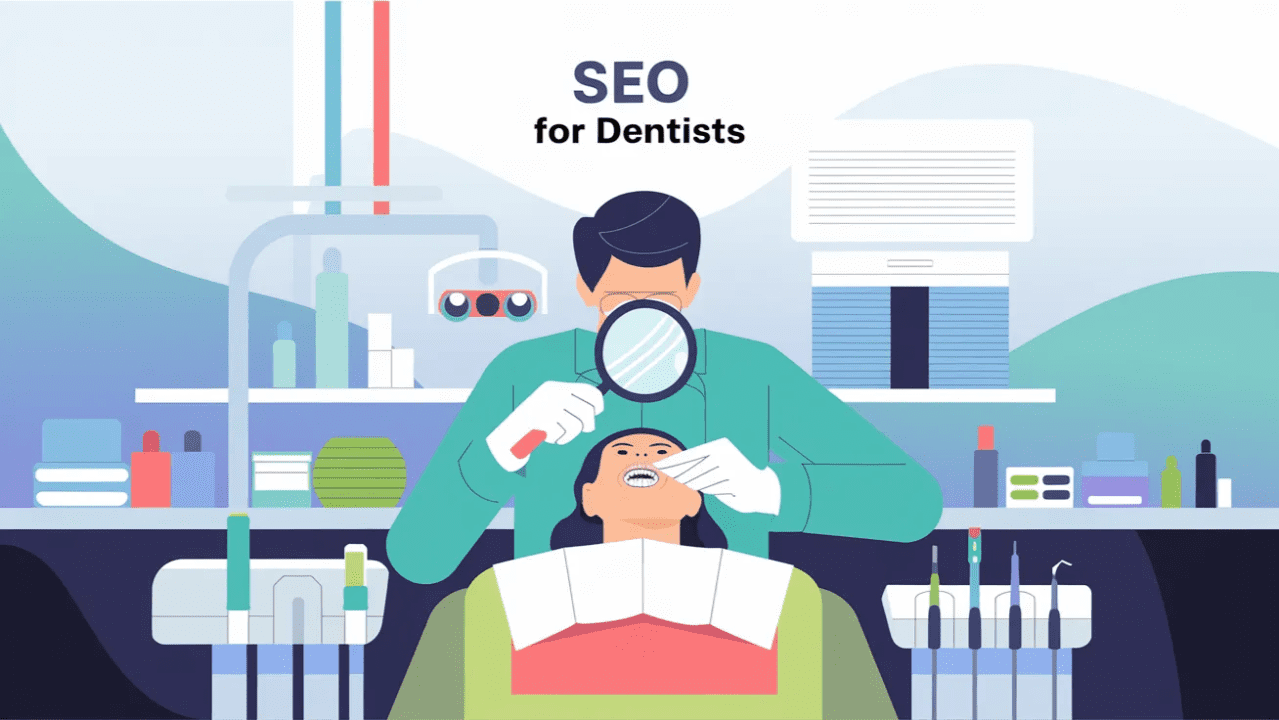Your dental practice website sits somewhere on page seven of Google search results. Meanwhile, your competitor down the street appears at the top every time someone searches “dentist near me.” The difference? A strategic approach to dental SEO that turns search engines into your most reliable patient acquisition channel.
Dental SEO isn’t about gaming algorithms or stuffing keywords into web pages. It’s about making your practice visible to people actively searching for dental services in your area. When executed properly, SEO becomes a sustainable growth engine that brings qualified patients to your practice month after month.
This guide breaks down exactly what professional dental SEO services include, why each component matters, and how to evaluate whether you’re getting real value or empty promises. Whether you’re considering hiring an agency or trying to understand what your current provider actually does, you’ll walk away with a clear picture of what effective dental SEO looks like.
Understanding the Foundation of Dental SEO
Dental SEO operates differently from general business SEO because local intent drives nearly every search. When someone needs a dentist, they’re not looking for information—they’re looking for a provider they can visit. This local focus shapes every aspect of an effective dental SEO strategy.
Why Local Search Dominates Dental Marketing
Most dental patients search for services within five miles of their home or workplace. Google recognizes this pattern and prioritizes local results for dental-related queries. The “local pack”—those three map listings that appear at the top of search results—captures the majority of clicks for dental searches.
Your potential patients use specific search patterns. They might search “emergency dentist open now,” “pediatric dentist accepting new patients,” or “cosmetic dentistry [city name].” Each search reveals different intent and different stages of the patient journey. Effective dental SEO addresses all these variations.
Search behavior has shifted dramatically toward mobile devices. More than 60% of dental searches happen on smartphones, often while people are actively looking for immediate care. Your SEO strategy must account for this mobile-first reality and optimize accordingly.
Core Components That Drive Results
Dental SEO services encompass multiple disciplines working together. Think of it as a symphony where each instrument plays a vital role in creating the complete sound. Remove one element, and the entire performance suffers.
Technical optimization ensures search engines can properly crawl, understand, and index your website. This foundation includes site speed, mobile responsiveness, secure connections, and proper site architecture. Without solid technical foundations, other SEO efforts struggle to gain traction.
On-page optimization involves crafting content and page elements that align with what patients search for and what search engines reward. This includes optimizing title tags, meta descriptions, headers, and content for both relevance and user experience.
Off-page factors—primarily backlinks and citations—signal to search engines that your practice is trustworthy and authoritative. Quality matters far more than quantity here. A single link from your local dental society carries more weight than dozens of directory listings on obscure websites.
Technical Optimization: Building a Solid Foundation
Your website’s technical health determines whether search engines can effectively index and rank your pages. Even the best content won’t rank if technical issues prevent search engines from accessing it properly.
Site Speed and Performance Optimization
Page load time directly impacts both search rankings and patient conversion rates. Google uses site speed as a ranking factor, but more importantly, slow sites frustrate users. When someone searches for an emergency dentist, waiting five seconds for your page to load might send them to a competitor instead.
Professional dental SEO services audit your site speed and implement specific improvements. This includes optimizing image sizes, enabling browser caching, minifying code, and leveraging content delivery networks. These technical adjustments might seem invisible to users, but they create measurable improvements in both rankings and user experience.
Mobile optimization deserves special attention. Google uses mobile-first indexing, meaning it primarily uses the mobile version of your site for ranking purposes. Your site must load quickly on smartphones, display properly on small screens, and allow easy navigation with touch controls.
Structured Data and Schema Markup
Schema markup is code that helps search engines understand your content better. For dental practices, specific schema types can enhance how your practice appears in search results.
Local business schema tells search engines your practice name, address, phone number, hours, and services. The medical business schema adds information about accepted insurance, emergency services, and practitioner credentials. Review schema can display star ratings directly in search results, increasing click-through rates.
Implementing the schema correctly requires technical expertise. The code must be properly formatted and include accurate information. When done right, schema markup can earn your practice rich snippets—enhanced search listings that stand out from standard results.
Security and HTTPS
Google has confirmed that HTTPS is a ranking signal. More importantly, browsers now display warnings for non-secure sites, which damages trust with potential patients. An SSL certificate that enables HTTPS is non-negotiable for modern dental websites.
Beyond rankings, security matters for patient data protection. Even basic contact forms collect personal information that deserves protection. Implementing proper security measures demonstrates professional responsibility and builds patient confidence.
On-Page Optimization: Speaking the Language of Search
On-page optimization bridges the gap between what patients search for and what your website offers. This involves strategic content creation and meticulous attention to page-level elements that influence rankings.
Keyword Research and Targeting
Effective keyword research goes beyond identifying high-volume search terms. It uncovers the specific phrases your ideal patients use when searching for dental services.
Professional SEO services conduct comprehensive keyword research that includes both broad service terms (“teeth whitening”) and long-tail variations (“affordable teeth whitening for sensitive teeth”). They analyze search volume, competition levels, and commercial intent to prioritize which keywords to target.
Geographic modifiers matter tremendously for local dental practices. Keywords should target your city, neighborhood, and surrounding areas. Someone searching “cosmetic dentist downtown Seattle” has a different intent than someone searching “cosmetic dentist Bellevue,” even though the cities are adjacent.
Patient questions represent valuable keyword opportunities. Phrases like “how much does a root canal cost” or “what to expect during wisdom teeth removal” indicate information-seeking behavior. Creating content that answers these questions establishes expertise and captures patients earlier in their decision journey.
Content Creation and Optimization
Content serves multiple purposes in dental SEO. It helps pages rank for target keywords, demonstrates expertise to potential patients, and provides the information people need to choose your practice.
Service pages form the backbone of dental practice websites. Each major service—general dentistry, cosmetic procedures, orthodontics, pediatric dentistry—deserves a dedicated, well-optimized page. These pages should include detailed service descriptions, benefits, procedures, and calls to action.
Content quality matters far more than quantity. A 1,500-word comprehensive guide to dental implants that addresses patient concerns and questions will outperform ten thin 300-word pages with minimal information. Search engines reward depth and thoroughness.
Title tags and meta descriptions act as advertisements in search results. The title tag should include primary keywords and compelling language within 60 characters. The meta description has 155 characters to persuade searchers to click your result instead of competitors’.
Header tags (H1, H2, H3) structure content for both readers and search engines. The H1 should include your primary keyword and clearly state what the page covers. Subheadings break content into scannable sections and provide opportunities to include related keywords naturally.
Internal Linking Strategy
Internal links connect pages within your website, distributing authority and helping search engines understand site structure. Strategic internal linking strengthens your SEO in ways many practices overlook.
Every page should link to related content in natural, helpful ways. A dental implants page might link to pages about bone grafting, sedation options, and financing. These connections help patients discover relevant information and signal to search engines which pages are most important.
Anchor text—the clickable words in a link—should clearly indicate what the destination page covers. Instead of “click here,” use descriptive phrases like “learn about our sedation dentistry options.” This provides both user value and SEO benefit.
Local SEO: Dominating Your Geographic Market
Local SEO determines whether your practice appears when nearby patients search for dental services. This specialized aspect of dental SEO requires specific tactics that differ from general SEO strategies.
Google Business Profile Optimization
Your Google Business Profile (formerly Google My Business) might be your most valuable digital asset. It determines whether you appear in the local pack and how your practice displays in Google Maps.
Complete optimization means filling out every possible field with accurate information. This includes business name, address, phone number, website, hours, services, attributes (like “wheelchair accessible” or “accepts new patients”), and a compelling business description.
Categories matter significantly. Your primary category should be “Dentist” or a specific specialty like “Cosmetic Dentist” or “Pediatric Dentist.” Additional categories can include services like “Teeth Whitening Service” or “Dental Implants Provider.”
Photos humanize your practice and increase engagement. Upload high-quality images of your office exterior and interior, treatment rooms, technology, and team members. Practices with photos receive more profile views and engagement than those without.
Regular posting keeps your profile active and provides opportunities to share updates, special offers, and helpful content. Google Business Profile posts appear directly in your listing and can influence whether potential patients contact your practice.
Local Citations and NAP Consistency
Citations are online mentions of your practice name, address, and phone number (NAP). These references appear on directory sites, healthcare platforms, social media, and other websites across the internet.
NAP consistency means your business information appears identically everywhere. Variations—even minor ones like “Street” versus “St.” or including versus omitting a suite number—confuse search engines and dilute the ranking power of your citations.
Professional dental SEO services audit existing citations, correct inconsistencies, and build new citations on relevant platforms. Priority directories include Yelp, Healthgrades, Zocdoc, and local business directories specific to your area.
Healthcare-specific platforms deserve special attention. Listings on dental-specific directories and healthcare review sites provide both SEO value and patient acquisition opportunities. These platforms often rank well for dental searches, giving you additional visibility.
Link Building: Establishing Authority and Trust
Backlinks—links from other websites to yours—remain one of the most powerful ranking factors. However, link building for dental practices requires careful strategy because quality dramatically outweighs quantity.
Earning Local and Industry-Relevant Links
The most valuable links come from locally relevant and industry-authoritative websites. A link from your city’s chamber of commerce, a local news article about your community involvement, or a mention on a dental association website carries significant weight.
Community involvement creates natural link opportunities. Sponsoring local events, participating in charity initiatives, or hosting educational seminars often results in mentions and links from community organizations and local media.
Educational content attracts links from other websites. Creating comprehensive guides, research summaries, or helpful resources makes your website link-worthy. Other sites—including local health blogs and community resources—may reference your content, generating valuable backlinks.
Professional relationships within dentistry can lead to link opportunities. Guest posting on dental industry blogs, participating in expert roundups, or collaborating with dental suppliers and manufacturers can generate authoritative backlinks.
Content Marketing: Attracting and Educating Patients
Content marketing extends beyond basic website pages to include blog posts, videos, infographics, and other resources that attract potential patients and establish expertise.
Blog Strategy for Patient Acquisition
A strategic blog answers questions patients ask at different stages of their dental journey. Early-stage content addresses general dental health and prevention. Mid-stage content explains specific procedures and treatment options. Late-stage content handles cost concerns, financing, and what to expect during appointments.
Frequency matters less than consistency and quality. Publishing one excellent, comprehensive post monthly outperforms weekly thin, rushed posts. Each article should thoroughly address its topic and provide genuine value to readers.
Topic selection should balance patient needs and search opportunity. Use keyword research to identify questions patients ask, then create content that provides better answers than competing websites. Look for topics where current results are thin or outdated.
Measuring Success: Analytics and Reporting
Effective dental SEO requires ongoing measurement and adjustment. Data-driven decisions ensure your investment generates real business results, not just vanity metrics.
Key Performance Indicators That Matter
Organic search traffic measures how many people find your website through non-paid search results. This metric should trend upward over time as SEO efforts compound.
Keyword rankings show where your website appears for target search terms. Track rankings for your most important service and location-based keywords. Improvements here often precede traffic increases.
Conversion metrics matter most because traffic without appointments provides no business value. Track form submissions, phone calls, and appointment bookings attributed to organic search. These numbers connect SEO directly to practice growth.
Local pack rankings determine visibility for high-intent searches. Monitor whether you appear in the map pack for key service searches in your area. These positions generate substantial patient inquiries.
Understanding the Timeline for Results
SEO is not an overnight solution. Most practices see initial improvements within 3-4 months, with significant results materializing around the 6-12 month mark. This timeline reflects how search engines evaluate and reward sustained quality.
Technical fixes and on-page optimization often show results faster than link building and authority development. Quick wins might include improved rankings for practice name searches or better visibility for long-tail keywords with lower competition.
Competitive markets require longer timelines. If you’re entering a saturated market where competitors have years of SEO investment, expect a longer path to top rankings. However, consistent execution still yields results over time.
Algorithm updates can cause ranking fluctuations. Google updates its algorithm frequently, sometimes causing temporary volatility. Professional SEO services monitor these changes and adjust strategies accordingly.
Choosing the Right Dental SEO Service Provider
Not all dental SEO services deliver equal value. Choosing a trusted dental marketing agency that understands how to evaluate and execute proven SEO strategies helps you avoid wasting money on ineffective tactics or, worse, damage to your online presence.
Questions to Ask Potential Providers
What specific strategies will you use for my practice? Vague answers like “we’ll optimize your site” indicate a lack of substance. Look for detailed explanations of technical optimization, content strategy, link-building approach, and local SEO tactics.
How do you measure and report results? Providers should track meaningful metrics like organic traffic, keyword rankings, and conversion rates. Monthly reporting should clearly show progress and explain the work performed.
Can you provide case studies or examples from other dental practices? Established providers should demonstrate proven results with similar clients. Ask for specific examples of ranking improvements and business growth.
What happens if I stop service? Understand what you own versus what the agency controls. You should retain full ownership of your website, Google Business Profile, and all content created. Avoid providers who hold these assets hostage.



































